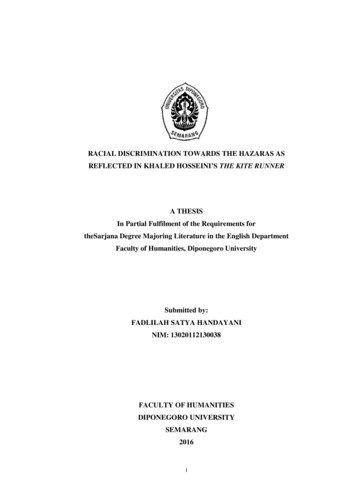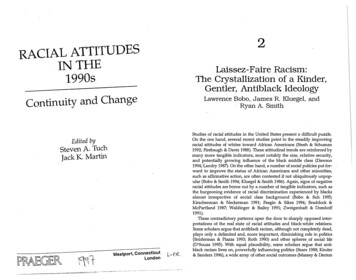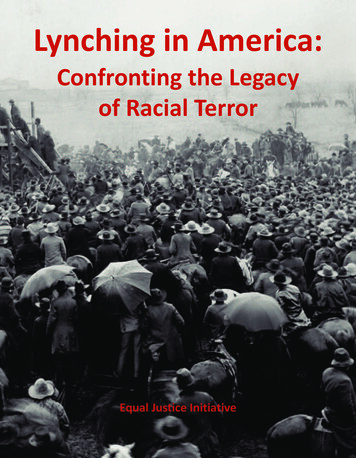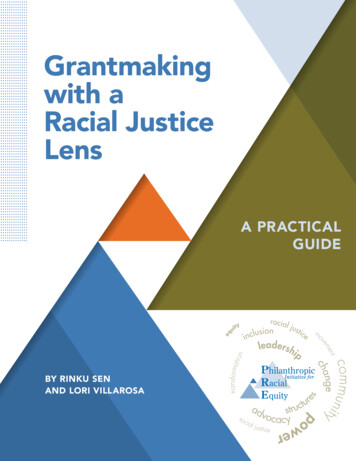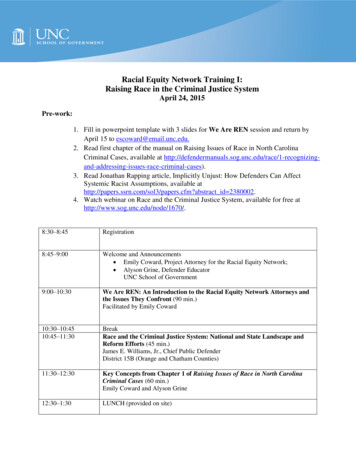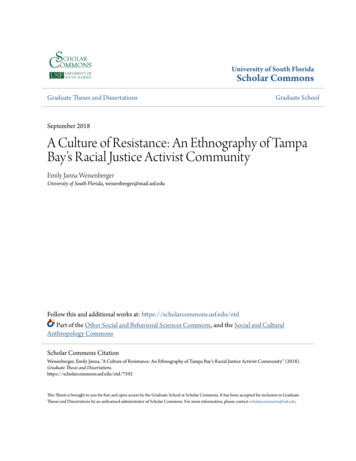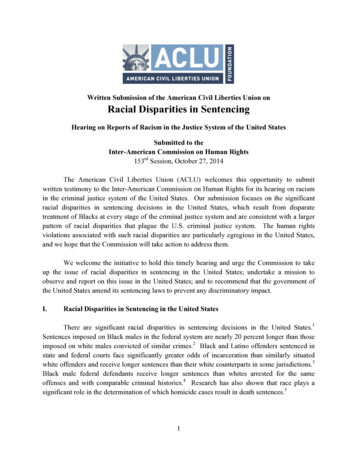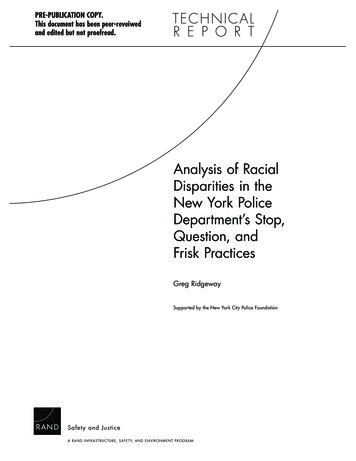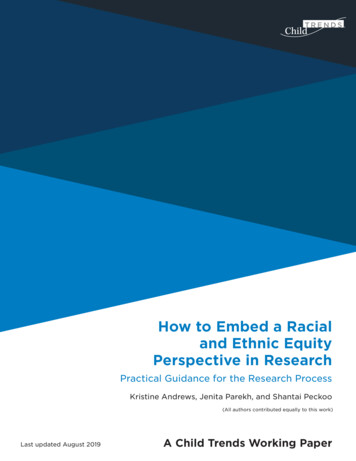
Transcription
TRENDSHow to Embed a Racialand Ethnic EquityPerspective in ResearchPractical Guidance for the Research ProcessKristine Andrews, Jenita Parekh, and Shantai Peckoo(All authors contributed equally to this work)Last updated August 2019A Child Trends Working Paper
Table of ContentsAcknowledgments . 1Executive Summary . 2Introduction. 4What is equity?. 5What is racial and ethnic equity? . 5What is racial and ethnic equity in research? . 6Why is a racial and ethnic equity perspective important? . 6What is the role of the researcher in advancing racial and ethnic equity? . 6Guiding Principles . 61. Examine their own backgrounds and biases. . 72. Make a commitment to dig deeper into the data. . 73. Recognize that the research process itself has an impact on communities, andresearchers have a role in ensuring research benefits communities. . 84. Engage communities as partners in research and give them credit. . 85. Guard against the implied or explicit assumption that white is the normative,standard, or default position. . 9Stages of the Research Process . 9Landscape Assessment . 10Know the context . 10Clarify the apparent issue or concern . 11Identify root causes. 12Figure 1: Example of Root Cause Tree. 13Design and Data Collection . 15Develop equitable research questions . 15Determine the research design . 16Gathering community input . 16Community considerations . 16Recruit study participants. 17Decide who is collecting the data . 17Identify data collection instruments . 18
Data Analysis. 19Quantitative data analysis . 20Disaggregate Data . 20Explore other facets of identity . 20Discuss trends in the data . 21Qualitative data analysis. 21Implicit biases in data analysis (quantitative and qualitative). 22Community involvement in data interpretation . 22Dissemination . 231. Audience . 242. Messaging . 24Presentations . 253. Medium. 254. Sustainability. 26Conclusion: Next Steps . 27Resources . 29Contextual Resources . 29Resources on Cultural Responsiveness & Equity . 30Landscape Assessment Resources . 31Research Design Resources . 31Qualitative and Quantitative Research Resources . 31Dissemination Resources . 32
AcknowledgmentsThe authors would like to thank the following individuals, whose expertise representsresearch, academic, grant-making, community practitioner, and policy-making spheres,for the contributions they made to this report by discussing their perspectives on racialand ethnic equity in research and evaluation:Alan JenkinsAnthony SimmonsCynthia ParkerDominica McBrideDonna MertensErika BernabeiEva Marie ShiversGlenn HarrisIbram KendiJara Dean-CoffeyJennifer C. GreeneJoanna Scottjohn a. powellKaren Fulbright-AndersonKatrina BledsoeKeith LawrenceLeon CaldwellLori VillarosaMaggie PotapchukManuel PastorMichael LopezNicole BowmanNonet SykesPaul ElamPaula DresselRaúl Quiñones-RosadoSally LeidermanShakti ButlerStafford HoodStephen ChangThomas LaVeistThomas SchwandtVictor RubinWendy ShaiaIn addition, the authors would like to thank Carol Emig, Deana Around Him, LaurenSupplee, Lina Guzman, Maria A. Ramos-Olazagasti, and Brandon Stratford for theirfeedback on earlier drafts of this practical guidance resource. We would also like to thankour Project Officer, Kantahyanee Murray, and the staff of The Annie E. Casey Foundationwho provided valuable insights and feedback.Finally, we would like to thank editors Janet Callahan and Brent Franklin, and designerCatherine Nichols, for finalizing the language and layout of this report.This research was funded by the Annie E. Casey Foundation. We thank them for their supportbut acknowledge that the findings and conclusions presented in this report are those of theauthor(s) alone and do not necessarily reflect the opinions of the Foundation.How to Embed a Racial and Ethnic Equity Perspective in Research: Practical Guidance for the Research Process1
Executive SummaryAt Child Trends, we believe that social science researchers and members of the broaderresearch community can contribute significantly to the important endeavor of embeddinga racial equity lens within their research. For child and youth researchers, meeting thisresponsibility to promote equity requires examining disparities in child and youthoutcomes by race and ethnicity. While disaggregating data is a necessary component ofsuch research, it is not sufficient. For child and youth research to inform and improvepolicies, programs, and public opinion, it must also identify, explore, and explain thefactors that contribute to disparate outcomes.To achieve these goals, child and youth researchers must incorporate a racial and ethnicequity perspective across the entire research process—in study design, data collectionand analysis, and interpretation and dissemination of data findings. Although child andyouth researchers may be greatly interested in how to include an equity perspective intheir work, there is little practical guidance for how to do so. This report aims to equipresearchers with tools and resources to integrate a racial and ethnic perspective inresearch.The report grew from an internal commitment by Child Trends to become moreintentional and skillful in incorporating a racial and ethnic equity perspective across ourresearch. As a first step, we scanned literature in child and youth research to find practicalguidance that could help us operationalize our commitment. However, the scan and asubsequent literature review revealed few examples for practical guidance. Instead, wefound resources that provide guidance on conducting culturally sensitive research. Whilesuch guidance is useful in addressing issues related to a specific culture, it does not equipresearchers with tools to understand the role of race and ethnicity in a person’s lifetrajectory, experiences, and outcomes. To adequately embed a racial and ethnic equityperspective in research, researchers should have access to tools to apply when developingresearch questions, collecting and analyzing data, and reporting findings that consider theracialized impact of a person’s life experience.With support from the Annie E. Casey Foundation, Child Trends undertook to identify anddevelop these practical tools for researchers in the child and youth field. As part of thiswork, we interviewed a diverse group of 34 researchers, funders, and policymakers fromacross the nation to learn more about integrating a racial and ethnic equity perspectivewhen conducting research and evaluation. The guidance in this document combines theseexperts’ knowledge, their recommended resources, resources that we found in theliterature, and the expertise of research staff at Child Trends.Every research project is unique; there is no “one-size-fits-all” approach to incorporating aracial and ethnic equity perspective in research. However, researchers might considersome overall guiding principles:1. Examine their own backgrounds and biases.How to Embed a Racial and Ethnic Equity Perspective in Research: Practical Guidance for the Research Process2
2. Make a commitment to dig deeper into the data.3. Recognize that the research process itself has an impact on communities, andresearchers have a role in ensuring research benefits communities.4. Engage communities as partners in research.5. Guard against the implied or explicit assumption that white is the normative,standard, or default position.We apply each of these principles to the major stages of the research process to furtherunderstand racial and ethnic inequities and help ensure that the research process doesnot perpetuate them. Below is a summary of the practices researchers might embed ineach stage of the research process:1. Landscape Assessment: Before the study begins, the researcher should gain abetter understanding of the context in which the research will be conducted byengaging stakeholders to gather their perspectives on the issue or concern ofinterest. Community stakeholder engagement will shape the research process andmay uncover root causes of the issue.2. Design and Data Collection: The researcher should develop research questions anddesigns that aim to advance racial and ethnic equity. To this end, researchers caninvolve racially and ethnically diverse research teams, construct a research designthat is accepted by the community, develop research questions that target rootissues, and address equity when identifying data collection methods andinstruments.3. Data Analysis: In both qualitative and quantitative analysis, the researcher shoulddisaggregate data, explore intersectionality, discuss data trends with appropriatecontext, beware of implicit bias, and involve the community, where possible, in datainterpretation.4. Dissemination: The researcher should include the community as one of themultiple primary audiences of research findings, consider various formats forreporting findings, and prioritize actionable research findings that the communitycan use.We understand that embedding a racial and ethnic equity perspective is an iterative, timeconsuming process that will look different for each research study. It may not always bepossible or feasible to fully incorporate a racial and ethnic equity perspective due tofunding and time constraints and other parameters set by the funder; however,incorporating any of these elements into the research process is a step forward. We hopethat researchers will use this guidance as a springboard to develop specific and uniqueways to incorporate a racial and ethnic equity perspective in their work.Finally, this is a work in progress, and we look forward to revising as we learn more fromour own work and the work of research colleagues across the country.How to Embed a Racial and Ethnic Equity Perspective in Research: Practical Guidance for the Research Process3
IntroductionRacial and ethnic disparities are evident across awide range of child and youth indicators.1 Thereasons are complex and involve gaps in health,education, wealth, and employment that stemfrom the historical legacy of many institutions,events, and social and legal structures. These rootfactors include slavery, Jim Crow laws, AmericanIndian genocide, anti-immigrant policies andsentiments, the Zoot Suit Riots, the ChineseExclusion Act, internment of Japanese Americans,endorsement of the model minority myth, andstructural racism. More than 150 years sinceslavery ended and more than 50 years after theCivil Rights Act became law, racial or ethnicidentity still plays a role in defining a person’s lifecourse. Federal laws and policies forbiddiscrimination based on race and ethnicity;however, institutional policies and practices andsocial norms that perpetuate existing inequities, inboth overt and covert ways, have institutionalizedbias and racism. Communities of color have beenhistorically disadvantaged by these systemic andstructural barriers, which shape the experiencesand life trajectories of children, youth, andfamilies.In an increasingly diverse society, the persistentissues seen among racial or ethnic minoritiespartly reflect the fact that mainstream, majorityperspectives have also shaped the research thathas informed decision making about such issues.Research should not perpetuate disparities,inequalities, and stereotypes about populations ofcolor. Researchers who analyze data, evaluateprograms, measure outcomes, and makerecommendations for program and systemsTerminologyCommunities of color: Families or children otherthan those who are Non-Hispanic white-only (e.g.,Black, Hispanic, American Indians and AlaskaNatives [AI/ANs]).Community: A place where people reside andinteract, or a larger system that people are a part of(e.g., youth in foster care). We consider the membersof a community to have similar characteristics,experiences, or interests.Disparities: The unequal outcomes of one racial orethnic group as compared to outcomes for anotherracial/ethnic group.Disproportionality: The underrepresentation oroverrepresentation of a racial or ethnic groupcompared to its percentage in the total populationRacial and ethnic equity: Racial or ethnic identity nolonger predicts life outcomes.Racial and ethnic equity perspective: An approachto research and evaluation that adapts the researchprocess by applying tools and practices needed torecognize people of color’s experiences with unequalpower differentials and access to resources andopportunity, while considering historical and currentlived realities, including structural racism.Structural racism: A system in which public policies,institutional practices, cultural representations, andother norms work in various, often reinforcing waysto perpetuate racial group inequity. It includesdimensions of our history and culture that haveallowed privileges associated with “whiteness” anddisadvantages associated with “color” to endure andadapt over time. Structural racism is not somethingthat a few people or institutions choose to practice.Instead it has been a feature of the social, economicand political systems in which we all exist.1Children of color are more likely to die as infants and to begin school academically behind their white peers. In 2016, the infantmortality rate, per 1,000 live births, was 11.1 for black babies, 8.0 for American Indian babies, and 5.2 for Hispanic/Latino babies,compared to 4.8 for white babies. Minority youth are overrepresented in the juvenile justice and child welfare systems, as are minorityadults in prison. More minority individuals live in poverty—one in four blacks, one in four Native Americans, and one in fiveHispanics/Latinos are classified as poor.Kids Count Data Center. Infant mortality by race in the United States. Annie E. Casey Foundation. Retrieved 85,284How to Embed a Racial and Ethnic Equity Perspective in Research: Practical Guidance for the Research Process4
improvement therefore have a responsibility to embed a racial and ethnic equityperspective in their work. To do so, researchers must think critically about how theycollect, analyze, and present data to avoid masking disproportionalities or disparities thatdifferent racial and ethnic groups experience. They must pay disciplined attention to raceand ethnicity while analyzing problems, looking for solutions, and defining success.Traditional approaches to research and evaluation do not consistently reflect suchattention to racial and ethnic inequities. Some researchers are trained on concepts such ascultural context, cultural responsiveness, cultural competence, and cultural sensitivity.However, they may apply these concepts of “culture” in limited ways—to describedifferences in style, preference, and behavior—without accounting for fundamentaldifferences in how people experience social life, evaluate information, decide what is true,attribute causes to social phenomena, and understand their place in the world. A person’sracial and ethnic identity, and that person’s experiences with inequities related to theirrace and ethnicity, encompass this broader understanding of culture. To account for theseexperiences, researchers should do more than highlight racial or ethnic differences whenthey examine research outcomes. Researchers also need the knowledge and tools to use aracial and ethnic equity perspective so that they can think critically about how dataexplains, contradicts, or perpetuates the experiences of communities of color.Many of the practices outlined in this report are similar to those used in community-basedparticipatory research (CBPR). CBPR is a useful approach for promoting racial and ethnicequity; in particular, it is useful for collecting data and involving a community as an equalpartner in research. While a racial and ethnic equity perspective encompasses the CBPRapproach, it also goes beyond this approach, when possible, to explore root or systemiccauses of disparities, explicitly focusing on race and ethnicity. Like CBPR, research thatincorporates a racial and ethnic equity perspective is concerned with equitable processes,but it also strives to promote equitable outcomes.What is equity?Equity is just and fair inclusion. Equity is achieved by environments, systems, and policiesthat support equal access to opportunity.2What is racial and ethnic equity?Racial and ethnic equity is both an outcome and a process. As an outcome, racial andethnic equity is achieved when race or ethnic identity no longer predicts the course of aperson’s life, and all people have what they need to thrive, no matter where they live.3 As aprocess, racial equity is applied when those most impacted by structural racial inequityare meaningfully involved in the creation and implementation of the institutional policiesand practices that impact their lives.42Braveman, P., Arkin, E., Orleans, T., Proctor, D., & Plough, A. (2017, May 1). What is Health Equity? [Web log post]. Retrieved 05/what-is-health-equity-.html3What Is Racial Equity? (n.d.). Retrieved from what-is-racial-equity/4Ibid.How to Embed a Racial and Ethnic Equity Perspective in Research: Practical Guidance for the Research Process5
What is racial and ethnic equity in research?Racial and ethnic equity in research means applying tools and practices needed torecognize people of color’s experiences with unequal power differentials and access toresources and opportunity, while considering historical and current lived realities,including structural racism.Why is a racial and ethnic equity perspective important?Conducting research with a racial and ethnic equity perspective produces findings thatmore accurately reflect or incorporate the life experiences of children and youth of color.This research, in turn, provides policy and decision makers with information that helpsthem understand and address the underlying structural factors that perpetuate inequity.What is the role of the researcher in advancing racial and ethnicequity?Based on our interviews with researchers whose work examines racial disparities, culturalsensitivity, cultural responsiveness, racial and ethnic equity, and related issues, as well asour own expertise as researchers, we identified ways that researchers can contribute toracial and ethnic equity:1. Identify the underlying factors that contribute to the existence and maintenanceof disparities. Researchers provide credible data on relevant topics as well asinformed solutions to equip policymakers and others to make thoughtful andevidence-informed decisions.2. Serve as a bridge between communities of color and those who make decisions,such as policymakers. Researchers can directly engage communities of color, elicitauthentic stories of where inequities exist, and include community voices in theresearch process in ways that inform strategies, policies, and interventions.3. Help build better data systems. For example, researchers can build communityand program capacity to collect data by ensuring that data related to race andethnicity, and indicators of diversity within racial and ethnic groups (e.g., country oforigin, immigration status) are collected and entered consistently and accuratelyby programs.4. Advocate within their institutions to make changes at a system level. Forexample, researchers can advocate to increase the racial and ethnic diversity ofresearchers, build the pipeline of scholars from diverse backgrounds andexperiences, and institutionalize a racial and ethnic equity approach in theirstandard research processes (e.g., in Institutional Review Board (IRB) or peerreview procedures).Guiding PrinciplesEvery research or evaluation project is unique in its approach. Each project seeks toanswer a specific range of research questions; thus, there can be no universal prescriptiveformula for how to embed a racial and equity perspective in research. However,How to Embed a Racial and Ethnic Equity Perspective in Research: Practical Guidance for the Research Process6
foundational principles can guide each research project to intentionally embed a racialand ethnic equity perspective. Based on 34 interviews with researchers, funders,academics, community practitioners, and policymakers; a thorough literature review; andthe deep research experience and expertise of Child Trends scientists, we developed fiveguiding principles on how to use this approach in every phase of research (from designingthe study to reporting findings). These principles are designed for researchers to apply asthey consider how their personal biases affect the collection and interpretation of thedata, commit to uncovering underlying causes of disparities, ensure that research givesback to communities of color, engage the community as partners, and guard against themindset that white is the normative standard for outcomes.While these principles can be applied to both quantitative and qualitative research, theguidance and examples here focus primarily on primary data collection and researchconducted in communities, as opposed to, for example, secondary analysis of data andoutcomes.The five principles that guide our strategies for incorporating a racial and ethnicperspective in research are presented below.1. Researchers should examine their own backgrounds and biases.Researchers strive to be neutral and objective; nevertheless, they have our own biases,values, background, and experiences that affect the way they conduct research. Biasaffects the decisions made throughout the research process, including who asks theresearch questions, which questions are asked, whose input on the research is sought,how the data are gathered, how findings are interpreted and communicated, and whichaudiences and methods are selected for dissemination. Researchers should examine theirown racial, ethnic, and cultural backgrounds, as well as their experiences (or lack ofexperiences) with racism and/or privilege, and consider how they influence the directionof research. Researchers should not assume that ensuring a racial and/or ethnic matchbetween researcher and the population of study is sufficient to remove bias from a study;rather, they need to pay careful attention to all sources of bias in a study.2. They should make a commitment to dig deeper into the data.While recognizing differences in outcomes among racial and ethnic groups is a first step inidentifying disparities, it does not address them. Addressing disparities requiresresearchers to move beyond simply documenting them: We must also identify theunderlying systemic and contextual causes of disparities. This focus is especially criticalfor understanding outcomes in communities of color, where truths have historically beendistorted or overlooked to perpetuate racist systems and beliefs. We should dig deeper touncover whether data points to a legacy of racism or systemic inequities at the root ofracial and ethnic differences in outcomes, rather than an intrinsic deficit of the populationin question. To dig deeper into the data requires that we ask questions to uncover rootcauses of disparities, seek the involvement and perspectives of community stakeholders,and invest adequate time and money in designing and implementing the research.Following these practices is especially important for understanding the experiences andoutcomes of American Indian (AI) and Alaska Native (AN) communities that haveHow to Embed a Racial and Ethnic Equity Perspective in Research: Practical Guidance for the Research Process7
historically been under-researched. Similarly, Asian American, Native Hawaiian, andPacific Islander populations are often under sampled and are combined in research.53. Researchers should also recognize that the research processitself has an impact on communities, and that researchers have arole in ensuring that research benefits communities.Historically, researchers have employed practices that resulted in the inhumane abuseand exploitation of communities and people of color. Researchers have obtained data oncommunities and then left without addressing the issues of the people they studied. Bydoing so, researchers have reinforced a paradigm in which they enter a community andconduct research without giving back6; in this way, they have added to the abuse andexploitation that vulnerable
2. Design and Data Collection: The researcher should develop research questions and designs that aim to advance racial and ethnic equity. To this end, researchers can involve racially and ethnically diverse research teams, construct a research design that is accepted by the community, develop research questions that target root

